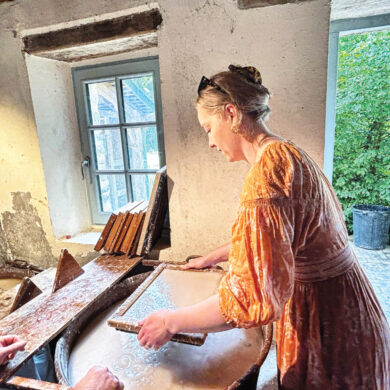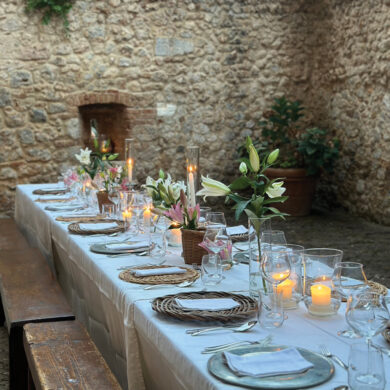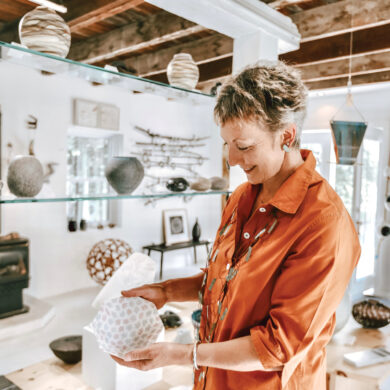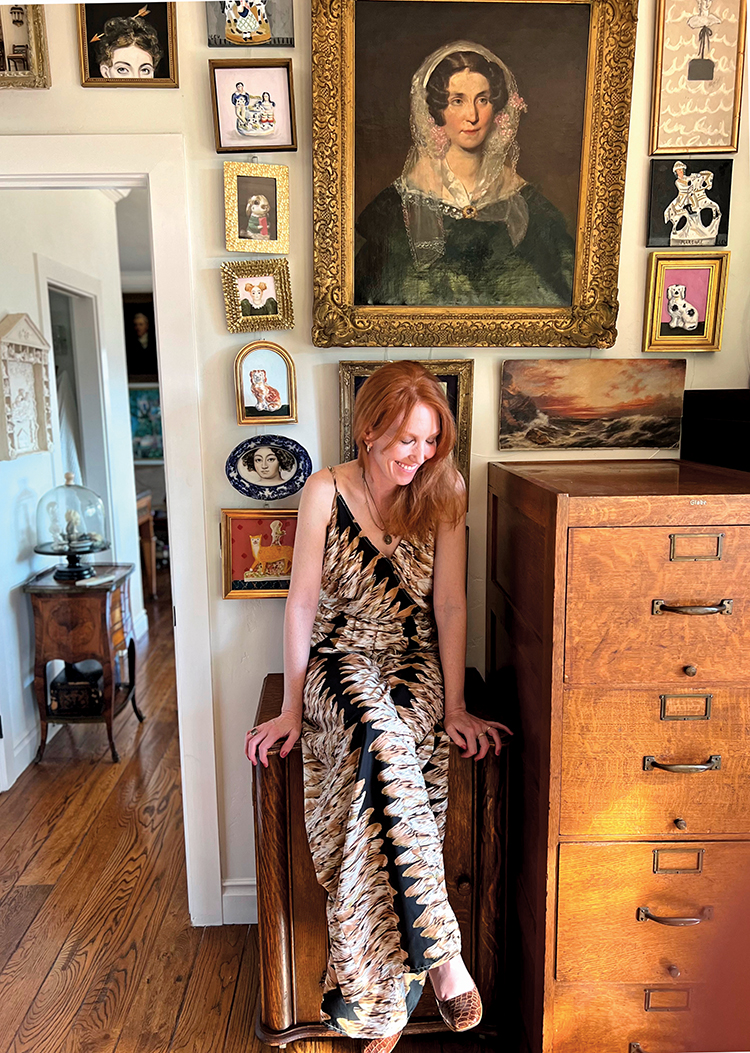
After having lived in Paris, Lyon, London, Cambridge, New Haven, San Francisco, and West Hollywood, it was a surprise to everyone when I moved back to the hills where I was raised and became an artist.
Not long after I arrived in St. Helena, California, a devastating forest fire ravaged the landscape but my house magically — thanks to a little roof sprinkler — survived. At a mere 570 square feet, it’s a tiny postage-stamp of a house with hardwood floors, Venetian plaster walls, reclaimed arched glass-paned French doors, and an expansive Brazilian hardwood deck. It was originally designed as a vacation home, so living in it required some small-space solutions; working in it required a second round of solutions; and now, my husband and his two large dogs will be spending less time at his turn-of-the-century farmhouse in Oregon and more time with Agatha and me here, so we’ve been implementing a third round of solutions!
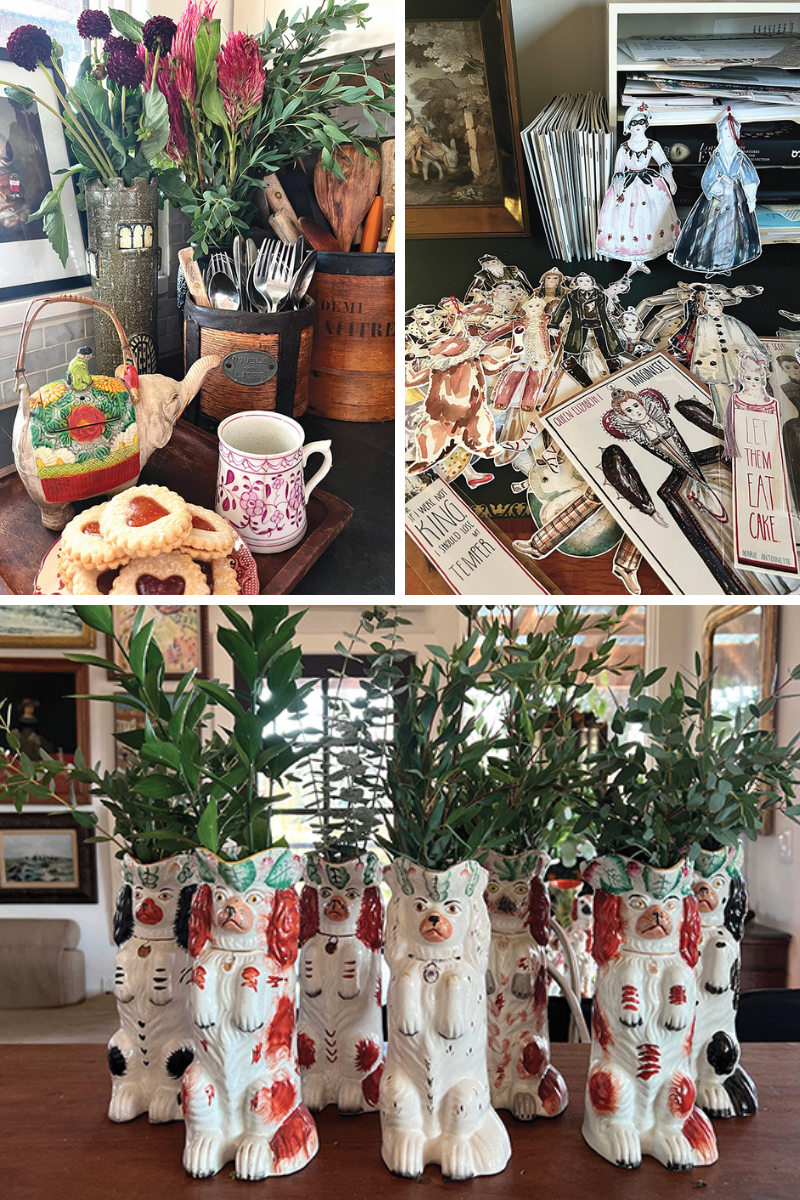
Increasingly, my home has become a studio one happens to live in rather than a house one happens to work in. Everything, consequently, must be well-ordered and positioned for maximum efficiency — but the aesthete in me demands that the storage be attractive and have what Robert Kime would have called a certain romanticism.
My mother is an antiques dealer and from my earliest memories to just yesterday, we’ve always gone shopping together at thrift stores, estate sales, and marchés aux puces. With very few exceptions, everything in this space has a second-hand history.
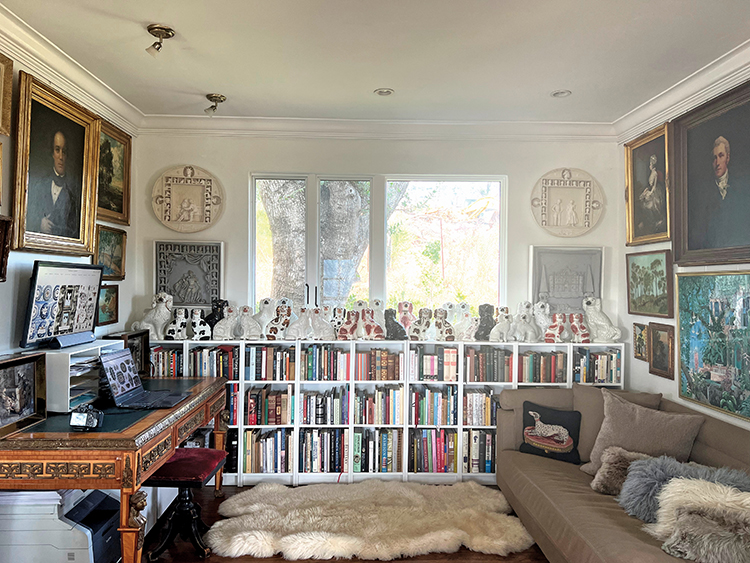
I have only a little shame when it comes to the Ikea Billy bookcases, since in various configurations they’ve held my library in all my houses. The books currently on display are weighted to literature, literary criticism, historical romances, art history, art technique, decor books, and antiques reference books. The ostentatious desk with the ormolu lion’s paw feet and busty Artemis caryatids is actually very practical with its expansive leather top.
The two round tables — the white marble in what’s supposed to be the dining room and the pink marble in the work corner of the bedroom — are ideal for oil painting, as they’re both in diffuse light-filled corners and 103 can be easily cleaned of gesso and paint. The contents of the bookcases under the window next to the dining table are hidden by a painting of jaguars, which is attached with simple magnet closures.
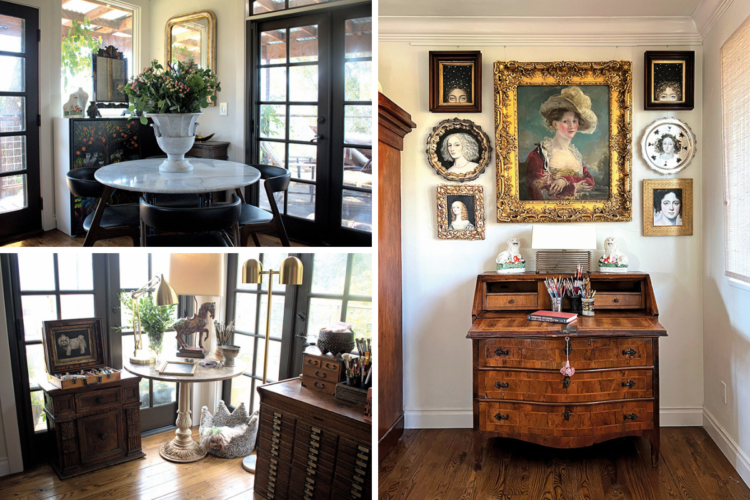
In the bedroom, the Victorian no-nonsense, mahogany-veneer armoire commands the room and is perfect for clothes storage. The 18th-century Italian marquetry serpentine chest has deep drawers for stacks of platters and frames and its drop-front desk with cubby holes is an ideal surface for painting with watercolors.
The real workhorses, however, are the antique cabinets: a large specimen cabinet from U.C. Berkeley (art supplies and small frames), a file cabinet that used to be my father’s (packing supplies), a sheet-music cabinet (giclée prints), and a map cabinet (illustration bookmarks and cards). Antique cabinets are not just well made and unimaginably practical, since they also have a calming, steadying influence and inspire one to sit down to work.
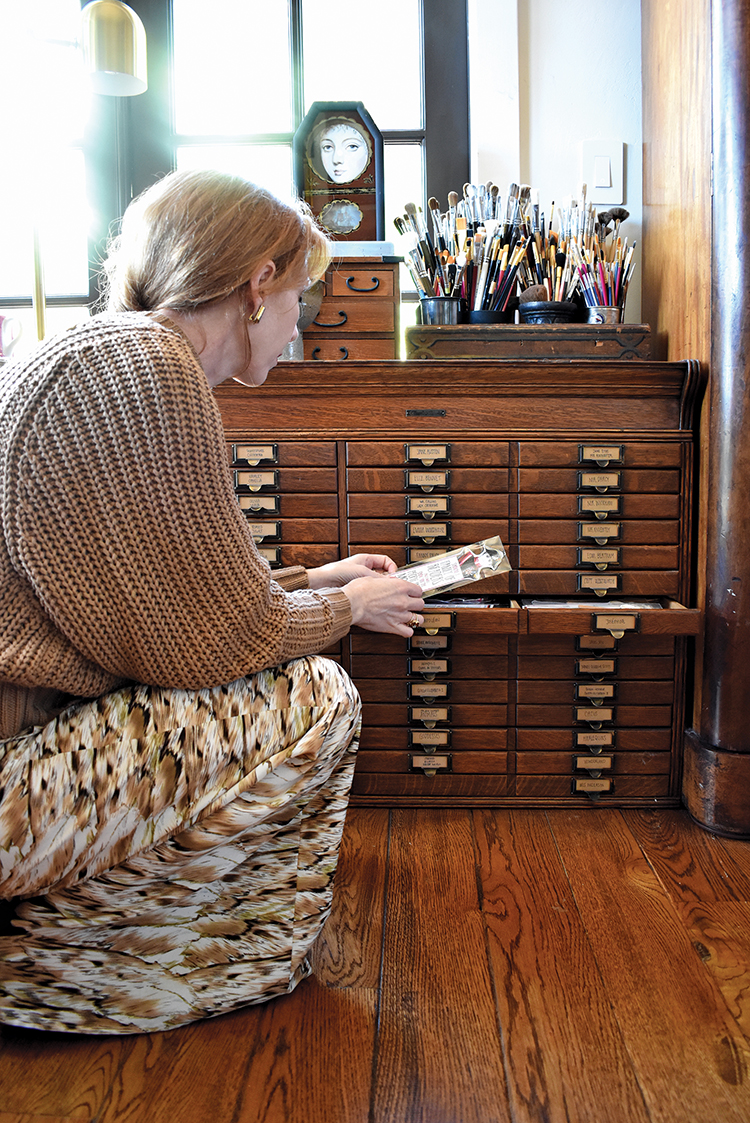
There are many elements at close quarters in this small space, but I’ve tried to pull them together by limiting myself to a restrained palette with a play of textures. To complement the hardwood floors and deck outside, I’ve included a variety of fine woods, including dark-stained Renaissance walnut, delicate Rococo marquetry tulipwood, and smooth Danish modern teak. For lightness and a certain neoclassical elegance, I love using marble wherever possible; and I can never resist indulging in giltwood, ormolu, and brass for old-world splendor.
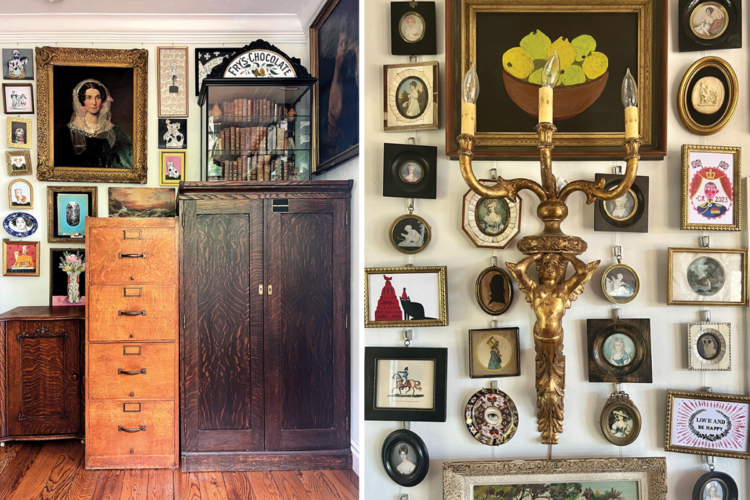
The walls are filled top to bottom with art: clay plaques by Ulisse Pagliari, a spirited young woman by George Henry Harlow, a girl surrounded with dancing dogs by Horacio Rentería Rocha, fanciful shadowboxes by Narcissa Niblack Thorne, imposing dark Victorian portraits, tiny delightful miniature portraits, the French landscapes my mother and I packed home in our suitcases from our brocante-buying trips in France, some of my favorite fun contemporary artist splurges (Alison Friend, Elle Yount, Ilse Coffman, Elena Likhatskaya, Unity Coombes, Josie Jurczenia, Sue Williams A’Court), and some of my own pieces since I’m not sure where else to store them.
It just so happened that I found the portraits of the gentlemen first and they took up residence in the living room. I found the portraits of the ladies next, and they found their places in the bedroom — thereby dividing this two-room house into what we can’t help but call the Men’s Room and the Ladies’ Room.
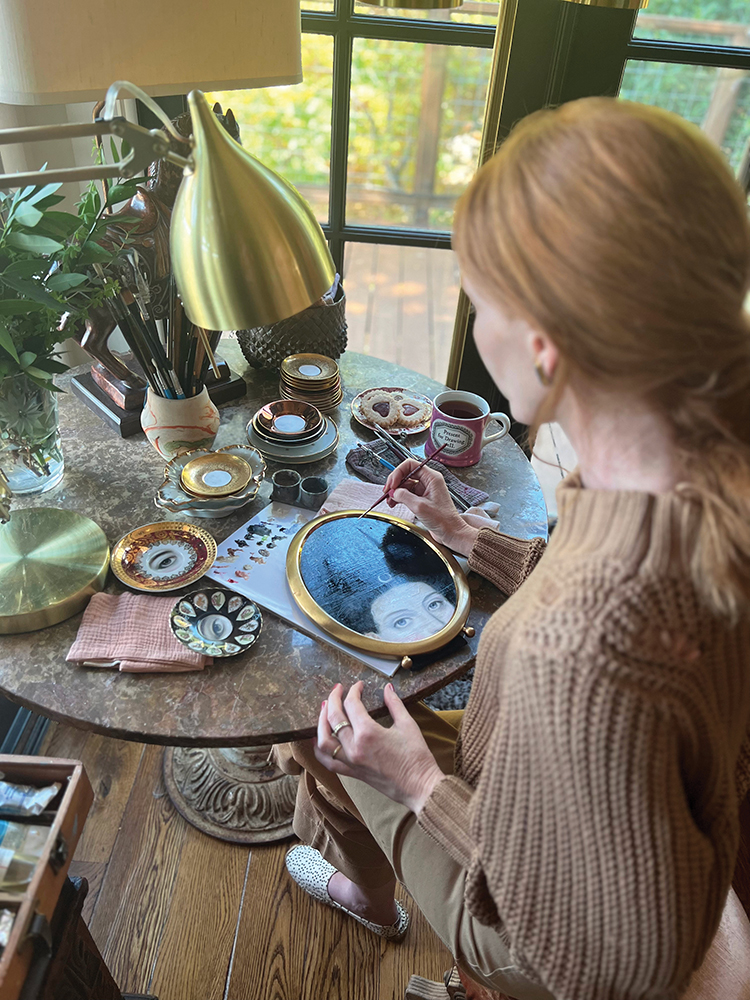
My inspiration comes from both art history and literary history. After earning degrees in philosophy, French and comparative literature at universities in the U.S. and France, for my Ph.D. from Yale and for two subsequent anthologies of literary criticism on Jane Austen and on Shakespeare, I worked with the great Harold Bloom. Rather unfashionably for his time, Harold was interested in the complexity and inwardness of characters, and in how we can learn from them and experience a sense of belonging in a world increasingly characterized by alienation and superficiality.
We know, and are in important ways known by, the great heroes and heroines of literature in a sense that’s in many ways more complete and more intimate than our relationships with other people. This is not to dismiss real-world relationships, but to acknowledge that literature creates the space for the experience of otherness that is requisite to true empathy.
The essence of this, I believe, is distilled in antique portraits in which the sitter gazes directly at the viewer across time: watching and being watched; knowing and being known. Whether by the great masters or by anonymous itinerant portraitists, and whether they’re as large as grandiose swagger portraits or as small as miniatures, these images capture a moment full of life, of connection, and of possibility.

For the most part, I paint portraits in a traditional style with modern compositions, presented in antique frames and on antique platters. My instincts are collaborative, and I’m unmoved by a blank canvas but delighted to share a project with an antique giltwood frame or Staffordshire platter. I let these found antique objects dictate what they’d like in terms of mood, color, composition, and character of the sitter.
My pieces are typically characterized by a tight crop which focuses our eyes even more intently on the subject’s eyes. In smaller frames and dishes, I paint lover’s eyes. From 1780-1830, tiny eyes were copied on small pieces of ivory, set in jewels, and worn as brooches pinned close to the heart as cherished talismans, clandestine proclamations of love, playful social guessing games, and the metonymic possession of a distant or departed beloved. The modern compositions of my work contrast with the historical element and create what I hope is a warm feeling of belonging, of inquiry, and of otherness, thereby bringing attention to those close relationships that we’re losing at an alarming rate in our disconnected modern society, but that were once — and can be again — the currency of everyday life.
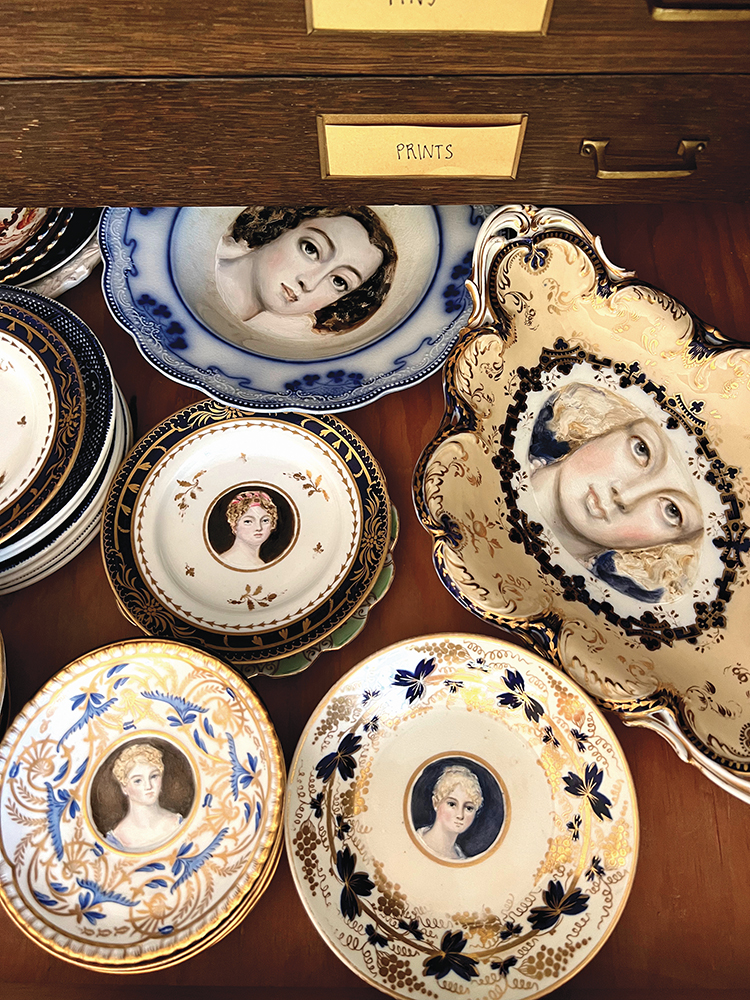
I originally learned to paint with watercolor and, since I’ve never been properly trained, I use oils in similar ways, building up colors from white and allowing the natural luminousness of the white ground to shine through. Eye shadings, skin tones, or backgrounds are usually as dark as possible to contrast with the light and anchor the piece in history. For textures, on platters I frequently use both oils-as-oils and oils-as-watercolors in controlled organic patterns to create an unstudied, but in fact carefully crafted, effect that helps marry the painting with the ceramic setting.
There is some controversy as to whether artists should stick to one recognizable, brandable style or do whatever they please; and, as I have no self-restraint, I also paint cheerful, colorful storybook portraits. For the new Staffordshire Collection, the living room is a cluttered kennel of pottery spaniels and poodles: I’ve paired these antique figurines with portraits painted of them in this contemporary style.
In watercolors, I have a small business, Imaginiste, which is based on my illustrations of literary and historical figures. Also in the field of watercolors, my mother and I are currently channeling our combined antiquing obsessions into an illustrated guide to antiques, grounded in her experience and embellished with my writing and paintings.
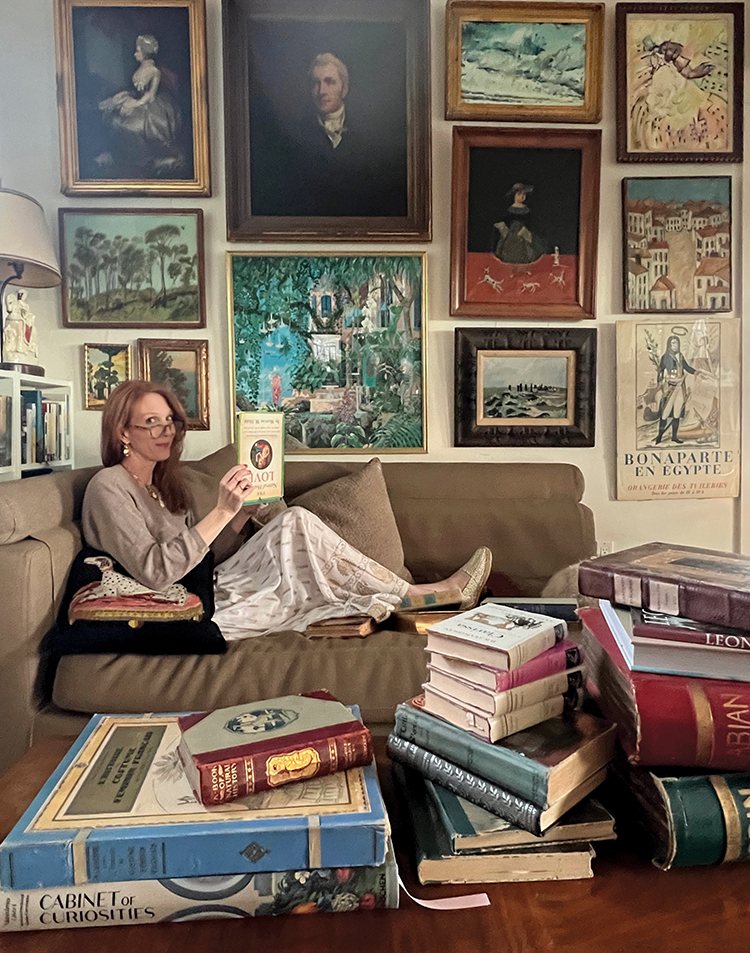
My mother is my collaborator; my lovely husband, Mike, is my business partner; and Agatha is my plucky art assistant. She is happy to stay at home, snoring beside me; and happy to go to town to the post office; and happy to go to Rome to the Sistine Chapel. Like me, she finds that while it’s exhilarating to go out adventuring, it’s even nicer to come back to a quiet and cozy home.

After having lived in Paris, Lyon, London, Cambridge, New Haven, San Francisco, and West Hollywood, it was a surprise to everyone when I moved back to the hills where I was raised and became an artist.
Not long after I arrived in St. Helena, California, a devastating forest fire ravaged the landscape but my house magically — thanks to a little roof sprinkler — survived. At a mere 570 square feet, it’s a tiny postage-stamp of a house with hardwood floors, Venetian plaster walls, reclaimed arched glass-paned French doors, and an expansive Brazilian hardwood deck. It was originally designed as a vacation home, so living in it required some small-space solutions; working in it required a second round of solutions; and now, my husband and his two large dogs will be spending less time at his turn-of-the-century farmhouse in Oregon and more time with Agatha and me here, so we’ve been implementing a third round of solutions!

Increasingly, my home has become a studio one happens to live in rather than a house one happens to work in. Everything, consequently, must be well-ordered and positioned for maximum efficiency — but the aesthete in me demands that the storage be attractive and have what Robert Kime would have called a certain romanticism.
My mother is an antiques dealer and from my earliest memories to just yesterday, we’ve always gone shopping together at thrift stores, estate sales, and marchés aux puces. With very few exceptions, everything in this space has a second-hand history.

I have only a little shame when it comes to the Ikea Billy bookcases, since in various configurations they’ve held my library in all my houses. The books currently on display are weighted to literature, literary criticism, historical romances, art history, art technique, decor books, and antiques reference books. The ostentatious desk with the ormolu lion’s paw feet and busty Artemis caryatids is actually very practical with its expansive leather top.
The two round tables — the white marble in what’s supposed to be the dining room and the pink marble in the work corner of the bedroom — are ideal for oil painting, as they’re both in diffuse light-filled corners and 103 can be easily cleaned of gesso and paint. The contents of the bookcases under the window next to the dining table are hidden by a painting of jaguars, which is attached with simple magnet closures.

In the bedroom, the Victorian no-nonsense, mahogany-veneer armoire commands the room and is perfect for clothes storage. The 18th-century Italian marquetry serpentine chest has deep drawers for stacks of platters and frames and its drop-front desk with cubby holes is an ideal surface for painting with watercolors.
The real workhorses, however, are the antique cabinets: a large specimen cabinet from U.C. Berkeley (art supplies and small frames), a file cabinet that used to be my father’s (packing supplies), a sheet-music cabinet (giclée prints), and a map cabinet (illustration bookmarks and cards). Antique cabinets are not just well made and unimaginably practical, since they also have a calming, steadying influence and inspire one to sit down to work.

There are many elements at close quarters in this small space, but I’ve tried to pull them together by limiting myself to a restrained palette with a play of textures. To complement the hardwood floors and deck outside, I’ve included a variety of fine woods, including dark-stained Renaissance walnut, delicate Rococo marquetry tulipwood, and smooth Danish modern teak. For lightness and a certain neoclassical elegance, I love using marble wherever possible; and I can never resist indulging in giltwood, ormolu, and brass for old-world splendor.

The walls are filled top to bottom with art: clay plaques by Ulisse Pagliari, a spirited young woman by George Henry Harlow, a girl surrounded with dancing dogs by Horacio Rentería Rocha, fanciful shadowboxes by Narcissa Niblack Thorne, imposing dark Victorian portraits, tiny delightful miniature portraits, the French landscapes my mother and I packed home in our suitcases from our brocante-buying trips in France, some of my favorite fun contemporary artist splurges (Alison Friend, Elle Yount, Ilse Coffman, Elena Likhatskaya, Unity Coombes, Josie Jurczenia, Sue Williams A’Court), and some of my own pieces since I’m not sure where else to store them.
It just so happened that I found the portraits of the gentlemen first and they took up residence in the living room. I found the portraits of the ladies next, and they found their places in the bedroom — thereby dividing this two-room house into what we can’t help but call the Men’s Room and the Ladies’ Room.

My inspiration comes from both art history and literary history. After earning degrees in philosophy, French and comparative literature at universities in the U.S. and France, for my Ph.D. from Yale and for two subsequent anthologies of literary criticism on Jane Austen and on Shakespeare, I worked with the great Harold Bloom. Rather unfashionably for his time, Harold was interested in the complexity and inwardness of characters, and in how we can learn from them and experience a sense of belonging in a world increasingly characterized by alienation and superficiality.
We know, and are in important ways known by, the great heroes and heroines of literature in a sense that’s in many ways more complete and more intimate than our relationships with other people. This is not to dismiss real-world relationships, but to acknowledge that literature creates the space for the experience of otherness that is requisite to true empathy.
The essence of this, I believe, is distilled in antique portraits in which the sitter gazes directly at the viewer across time: watching and being watched; knowing and being known. Whether by the great masters or by anonymous itinerant portraitists, and whether they’re as large as grandiose swagger portraits or as small as miniatures, these images capture a moment full of life, of connection, and of possibility.

For the most part, I paint portraits in a traditional style with modern compositions, presented in antique frames and on antique platters. My instincts are collaborative, and I’m unmoved by a blank canvas but delighted to share a project with an antique giltwood frame or Staffordshire platter. I let these found antique objects dictate what they’d like in terms of mood, color, composition, and character of the sitter.
My pieces are typically characterized by a tight crop which focuses our eyes even more intently on the subject’s eyes. In smaller frames and dishes, I paint lover’s eyes. From 1780-1830, tiny eyes were copied on small pieces of ivory, set in jewels, and worn as brooches pinned close to the heart as cherished talismans, clandestine proclamations of love, playful social guessing games, and the metonymic possession of a distant or departed beloved. The modern compositions of my work contrast with the historical element and create what I hope is a warm feeling of belonging, of inquiry, and of otherness, thereby bringing attention to those close relationships that we’re losing at an alarming rate in our disconnected modern society, but that were once — and can be again — the currency of everyday life.

I originally learned to paint with watercolor and, since I’ve never been properly trained, I use oils in similar ways, building up colors from white and allowing the natural luminousness of the white ground to shine through. Eye shadings, skin tones, or backgrounds are usually as dark as possible to contrast with the light and anchor the piece in history. For textures, on platters I frequently use both oils-as-oils and oils-as-watercolors in controlled organic patterns to create an unstudied, but in fact carefully crafted, effect that helps marry the painting with the ceramic setting.
There is some controversy as to whether artists should stick to one recognizable, brandable style or do whatever they please; and, as I have no self-restraint, I also paint cheerful, colorful storybook portraits. For the new Staffordshire Collection, the living room is a cluttered kennel of pottery spaniels and poodles: I’ve paired these antique figurines with portraits painted of them in this contemporary style.
In watercolors, I have a small business, Imaginiste, which is based on my illustrations of literary and historical figures. Also in the field of watercolors, my mother and I are currently channeling our combined antiquing obsessions into an illustrated guide to antiques, grounded in her experience and embellished with my writing and paintings.

My mother is my collaborator; my lovely husband, Mike, is my business partner; and Agatha is my plucky art assistant. She is happy to stay at home, snoring beside me; and happy to go to town to the post office; and happy to go to Rome to the Sistine Chapel. Like me, she finds that while it’s exhilarating to go out adventuring, it’s even nicer to come back to a quiet and cozy home.











